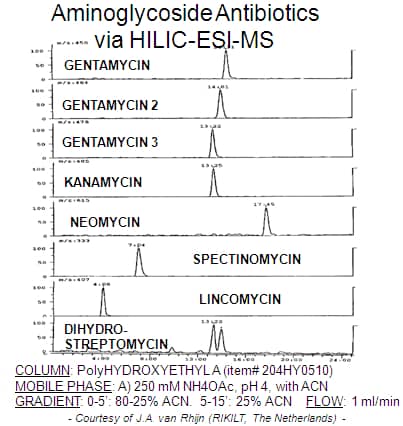Separation of Spectinomycin

Get In Touch
Salt Concentrations and Extremely Polar Small Solutes:
To obtain sharp, symmetrical peaks in HILIC for small polar solutes, the above salt levels are required in the mobile phase:
a) 10-15 mM: Typical polar solute, such as a neutral amino acid.
b) 40 mM: Solutes with a higher charge-to-mass ratio, such as
arginine.
c) > 120 mM: Solutes with an extremely high charge, such as
ATP or aminoglycoside antibiotics.
Fortunately, ESI-MS can tolerate up to 400 mM ammonium acetate in the mobile phase.
A plausible explanation is that the retention of highly-charged solutes is strongly influenced by the polarity of their counterions. A high concentration of salt insures that all the charged groups have the same counterions. If this is not the case, then the peak can be skewed. In an extreme case, two well-separated peaks can be obtained for a single pure solute, corresponding to the same solute with different counterions, with a continuum between them corresponding to molecules that exchanged their original counterions for those in the mobile phase during their migration through the column. This rate of exchange is slow on the time scale of HPLC if the salt level in the mobile phase is too low.
Normally, HILIC of small solutes is best done with a column with a high surface area; typically, 60- or 100-Å pore diameter. However, with extremely polar solutes such asaminoglycoside antibiotics, use of a 1000-Å material with a low surface area facilitates elution using convenient mobile phases, as in the above example:
Application Name : Application of Aminoglycoside Antibiotics
Column Name : PolyHYDROXYETHYL A™ Columns
Analytes : Gentamycin, Gentamycin 2, Gentamycin 3, Kanamycin, Neomycin, Spectinomycin, Lincomycin, Dihydro-Streptomycin
Application Name :
Get Your Quote or Call: 040-29881474
We focus on supporting laboratory workflows & optimizing lab-wide operations
